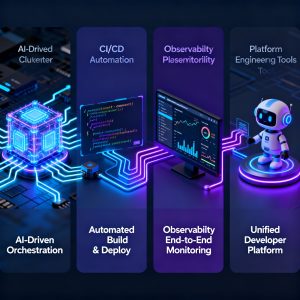As the speed of software delivery accelerates, so does the demand for smarter, faster, and more reliable testing. Continuous integration pipelines, larger datasets, and complex cloud architectures have pushed testing teams to reinvent how they ensure software quality.
In 2025, test automation is not just about execution speed—it’s about intelligence, collaboration, and scalability. Emerging technologies such as AI, blockchain, and self-healing automation are reshaping the future of QA. Below are the 20 key test automation trends driving the transformation of quality assurance across industries.
1. QAOps: Integrating Quality into DevOps
QAOps merges Quality Assurance (QA) with IT Operations, aligning testing directly with CI/CD workflows. It connects QA, Dev, and Ops teams through collaboration, automation, and shared dashboards.
Key advantages:
- Continuous learning for productivity and efficiency.
- Real-time collaboration between QA and DevOps teams.
- Faster bug resolution and earlier product releases.
- Enhanced performance, scalability, and customer experience.
QAOps ensures quality checks happen seamlessly across all development phases, embedding testing into the heart of DevOps pipelines.
2. Scriptless Automation Testing
Scriptless testing enables teams to build automation suites without writing complex code. Intuitive, record‑and‑playback tools make automation accessible for non‑technical testers, improving adoption and scalability.
Benefits include:
- Rapid test creation and reduced cost of automation.
- Faster configuration and lower maintenance overhead.
- Simplified test case reuse across multiple scenarios.
Leading scriptless tools such as BrowserStack Low‑Code Automation and Selenium IDE empower teams to focus on quality rather than coding syntax.
3. Headless Browser Testing
Headless browsers run automated tests without a graphical interface, simulating complete web interactions directly in the background.
Why it matters:
- Executes tests faster by removing UI rendering delays.
- Reduces instability and enhances reliability.
- Ideal for CI/CD pipelines and performance testing.
This approach streamlines “shift‑left” practices by enabling instant feedback earlier in the development cycle.
4. Shift‑Left Testing
“Shift‑Left” emphasizes testing early and often in the software development lifecycle (SDLC). By catching defects earlier, teams minimize rework costs and accelerate releases.
Advantages:
- Lower debugging costs.
- Improved product quality.
- Shorter delivery timelines.
Early integration of automated tests within CI/CD ensures that quality checks evolve alongside every code commit.
5. Microservices Testing
Microservices architectures divide software into modular services, each requiring precise validation. Automated testing across these distributed services ensures consistent system reliability.
Top benefits:
- Better scalability and data security.
- Enhanced fault tolerance and easier deployments.
- Shorter feedback loops for smaller service updates.
Tools like BrowserStack Automate and Postman support end‑to‑end validation across microservice dependencies, improving confidence in integrations.
6. AI and Machine Learning in Testing
Artificial intelligence (AI) and machine learning (ML) power predictive and adaptive test automation. These systems identify high‑risk areas, generate optimized tests, and automatically prioritize tasks.
Use cases:
- AI‑driven test case generation.
- Self‑healing of broken scripts.
- Failure prediction and analytics.
By adopting solutions such as BrowserStack Percy for AI‑based visual testing, teams can achieve pixel‑perfect consistency and detect UI regressions instantly.
7. Blockchain Testing
With enterprises adopting blockchain for secure transactions, blockchain testing ensures integrity, data security, and performance of distributed ledgers.
Benefits:
- Detects defects in decentralized systems.
- Confirms ledger synchronization and transaction accuracy.
- Measures scalability and real‑time performance.
Testing frameworks such as Truffle and Ethereum Tester support validation across transaction nodes and blockchain integrations.
8. Geolocation Testing
As applications become increasingly location‑based, geolocation testing validates regional performance and compliance with local regulations.
Benefits:
- Ensures accuracy of region‑specific functionalities.
- Checks behavior on devices from multiple countries.
- Validates content, language, and regional restrictions.
Tools like BrowserStack Live enable testing across thousands of device‑browser combinations to simulate real‑world environments worldwide.
9. Camera Image Injection Testing
For camera‑based mobile apps—QR code scanners, check deposits, or facial capture—camera image injection enables testing AI vision capabilities safely and precisely.
It replicates image inputs from real devices, validating camera workflows without requiring physical sensors.
10. Biometric Authentication Testing
Fingerprints, facial recognition, and iris scans are driving secure user experiences in apps. Automated biometric testing validates accuracy, speed, and reliability of these features.
Key benefits:
- Stronger authentication and faster onboarding.
- Validation of multiple biometric modes (dual authentication).
- Full integration with CI/CD pipelines.
11. Cloud‑Based Testing
Cloud infrastructure is replacing traditional local labs. Cloud‑based QA allows teams to run tests concurrently across browser‑OS combinations and real devices on demand.
Why it matters:
- No need for hardware maintenance.
- Supports instant scalability for global teams.
- Reduces operational costs through pay‑as‑you‑go models.
12. Parallel Testing
Parallel testing reduces execution time by running multiple test suites simultaneously. It’s a core strategy for speeding up continuous delivery while maintaining coverage.
Benefits:
- Shorter feedback cycles.
- Optimized resource utilization.
- Reduced test bottlenecks during releases.
13. Hyperautomation in QA
Hyperautomation combines AI, RPA, and analytics to achieve end‑to‑end workflow automation beyond repetitive tasks.
In QA, hyperautomation simplifies governance by automating defect triage, prioritization, and real‑time reporting across dynamic systems.
14. Codeless API Testing
Codeless API solutions democratize automated testing, enabling business analysts to validate complex integrations without writing scripts.
Advantages:
- Simplified validation across microservices architectures.
- Enhanced collaboration between QA and nontechnical stakeholders.
- Increased coverage with reduced coding dependency.
15. DevSecOps Test Automation
Security is now everyone’s responsibility. DevSecOps testing automation embeds vulnerability scanning directly within CI/CD pipelines.
Outcomes:
- Continuous compliance with security standards.
- Early detection of security flaws.
- Lower costs for post‑release remediation.
16. Self‑Healing Automation
Self‑healing frameworks detect when object locators or identifiers change and automatically update test scripts.
Key advantages:
- 60% less maintenance workload.
- Higher uptime for regression suites.
- Continuous test adaptability without manual fixes.
17. 5G Network Testing
As 5G coverage expands, applications must withstand varying latencies and bandwidth loads. Automated 5G testing focuses on evaluating speed, reliability, and streaming performance on modern networks.
18. AI‑Driven Test Data Generation
Machine learning helps generate realistic, compliant test datasets. These synthetic datasets eliminate the risk of exposing production data while mimicking real‑world behavior patterns.
Benefits:
- Enhances coverage for edge cases.
- Ensures data privacy compliance.
- Enables load simulation at scale.
19. IoT Test Automation
With billions of connected devices, IoT test automation validates interoperability, security, and reliability across distributed ecosystems.
By leveraging automation frameworks, teams can analyze interactions between sensors, networks, and cloud platforms efficiently.
20. Performance Engineering
Traditional load testing has evolved into performance engineering—an integrated practice focusing on continuous performance optimization throughout development.
Advantages:
- Proactive detection of bottlenecks.
- Improved responsiveness and scalability.
- Seamless collaboration between QA and operations.
What’s Driving the Future of Test Automation
Innovations like AI, machine learning, and IoT are redefining QA. Yet the forces shaping automation go deeper than technology alone:
- Agile & DevOps culture: Continuous testing practices accelerate delivery.
- Complex architectures: Microservices and APIs demand scalable automation.
- Rising customer expectations: Seamless experiences require rigorous validation.
- Regulatory compliance: Automated auditing ensures adherence to data and security laws.
- Device diversity: Expanding mobile ecosystems demand cross‑device automation strategies.
Elevating Quality in the Next Era
Test automation in 2025 is about adaptability, intelligence, and continuous optimization. From QAOps pipelines to AI‑driven predictive testing, the future of QA is deeply integrated with the software lifecycle.
Despite automation’s expansion, real‑device testing remains the gold standard for validating real‑world performance. Biometric checks, geolocation accuracy, and camera‑based features still rely on physical validation to ensure authenticity.
By embracing these automation trends, teams can achieve faster feedback loops, deliver flawless software, and meet the quality expectations of tomorrow’s digital users.
Read more such articles from our Newsletter here.



